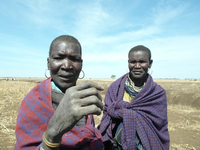
The Karamoja district in Northeast Uganda is the poorest areas in Uganda and one of the poorest regions in the world according to the United Nations Human Development Index. The long dry season makes farming difficult. People live by raising goats and cattle and selling charcoal and firewood. The Karamoja have a warrior tradition that was expressed through cattle raids and rustling in neighboring regions and across the border with Kenya. After a several-years campaign, the Ugandan army brought an end to most cattle raiding and confiscated over 30,000 guns. The Uganda government declared the campaign successful in 2011 but thousands of people had been killed, arrested, and tortured in the process according to many reports at the time.
The Karamojong have been resistant to many efforts to impose modernization. They have a nomadic tradition. Their stick and thatch Manyattas (villages) can be easily picked up and moved to better grazing territory. The long dry season argues against extensive gardening or crop planting. Education for children is not highly valued. Villagers resist using latrines or and other sanitation measures.
I traveled with two Makerere University faculty members Fred Kakinda and Simon Banga. Mildred Achen, a Makerere graduate student was our very capable guide and translator. Patrick Kyongera was our driver. Banga and Kakinda have been working to set up a children’s art training program that focusses on hygiene and sanitation issues and helps children express their feelings about the community’s long history of conflict and violence.
We got the P5 and P6 level kids to talk about and draw impressions of everyday life, and their visions of the future. Then they transferred the drawings onto an outside wall of the schoolhouse, and we created a 12’ by 6 foot mural based on the kids’ ideas. We had to work fast. The mural wall was in shade until noon. Then the blazing sun would make painting the wall extremely difficult and uncomfortable, so we had to finish the workshop and painting effort by noon.
The setting, the process and the end result can be seen in my photos on Flickr.
Also, see my video of traditional Karamoja dancing.
